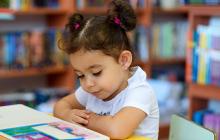Strategies for Supporting Young Students’ Home-Language Development During COVID-19—and Beyond

An abundance of research shows that early, rich linguistic experiences are crucial to later academic success for all children—whether they grow up using only one language or several. With COVID-19 still affecting in-person education across the country, early childhood educators have had to find new ways to give students, especially those who are dual-language learners (DLLs), these experiences. Despite the disruptions COVID-19 has caused to in-person education, the pandemic may present an unexpected opportunity. Educators can help foster DLLs' language and literacy development by partnering with families to build on the rich cultural and linguistic resources of these young learners’ home languages.
Dual language learners (DLLs) are children birth to age 5 who are learning another language in addition to English. In the U.S., most of these children live in a home/community where a language other than English is spoken.
Rich, early language experiences for dual language learners are wide-ranging. Critically, though, children who speak a language other than English at home can meet and often exceed expectations for both languages’ development. And when their home-language skills include (emergent) literacy skills, dual language learners have even better odds of academic success: the knowledge and skills they bring from their earlier linguistic experiences in many cases transfer to their later learning in English. Because so many DLLs are learning at home this school year, they can observe or participate in family activities and routines that they otherwise wouldn’t—cooking or household chores, for example—and this exposes them to new vocabulary and language practices. Older siblings can play a role, too, serving as both a model and a partner in English-language use and literacy practices, as well as in their shared home language.
How to Encourage Language Development
With all of this in mind, there are a number of ways early childhood educators can help families foster their children’s home language development, while also preparing them to succeed when they’re back in the classroom—whatever language(s) may be used there.
- Encourage families to read books together aloud—in the home language. Much of the practice of reading has less to do with the particular words on the page and more to do with the ideas and structure of a story’s narrative. Those narrative features may vary across cultures, but almost any text can allow children and their caregivers to practice fundamental literacy skills, such as asking open-ended questions and shared book-reading in the home language increases young DLLs’ use of expressive language in the second language. And just as importantly, it encourages maintenance of home language and cultural heritage, which in turn affirms social and emotional well-being.
- Help families find ways to play with language. In most families with dual language learners, adults and children have a range of experiences with English, just as they do with their home languages. Families can build on that experience by engaging in playtime activities that incorporate both languages with other ways of thinking and knowing. For example, families can draw pictures in a journal and talk about what they’ve drawn in their home language; then they can discuss how they might talk about it differently in English. Alternatively, they can listen to music in their home language and share themes they hear in the songs of the intersecting cultures they live in.
- Urge families to talk about what matters, even with young children. A robust vocabulary, a key component of both early and long-term academic success, is often a reflection of having had exposure to rich and varied content. Families can capitalize on this connection by engaging young DLLs in their home language in conversations about the world around them—in nature, in daily routines, and in media, like historical television programs and child-focused science videos. It doesn’t matter whether these activities and media also integrate some English; the key is to build knowledge. And if an adult doesn’t know the answer to a child’s question, they can look it up together. Nurturing curiosity, whatever the language, will help young children be motivated and ready to learn.
To be sure, these approaches applied well before the current COVID-19 environment. But now perhaps more than ever, early childhood educators can take this time as an opportunity to empower linguistically diverse families. By supporting their engagement in these and other creative ways, educators and caregivers can help DLLs continue to learn both of their languages, while also forging lasting school-family partnerships that will long outlive these challenging times.
This In the Field piece is part of a content series developed for the Innovation Hub at AIR. The Innovation Hub is a central platform that connects AIR experts, communities of practice (CoPs), and resources to support educators and members of the general public as they navigate instructional challenges related to the COVID-19 global pandemic.
More from the Innovation Hub:


